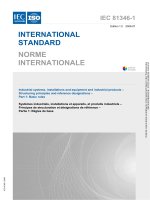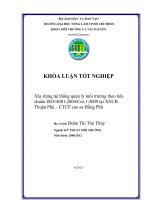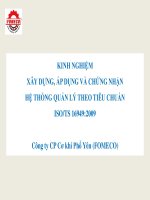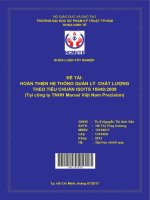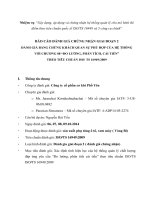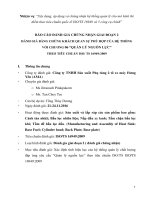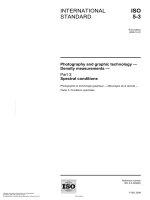Tiêu chuẩn iso 15835 1 2009
Bạn đang xem bản rút gọn của tài liệu. Xem và tải ngay bản đầy đủ của tài liệu tại đây (182.79 KB, 20 trang )
INTERNATIONAL
STANDARD
ISO
15835-1
First edition
2009-04-01
Steels for the reinforcement
of concrete — Reinforcement couplers
for mechanical splices of bars —
Part 1:
Requirements
Aciers pour l'armature du béton — Coupleurs d'armature destinés
aux raboutages mécaniques de barres —
Partie 1: Exigences
Reference number
ISO 15835-1:2009(E)
© ISO 2009
ISO 15835-1:2009(E)
PDF disclaimer
This PDF file may contain embedded typefaces. In accordance with Adobe's licensing policy, this file may be printed or viewed but
shall not be edited unless the typefaces which are embedded are licensed to and installed on the computer performing the editing. In
downloading this file, parties accept therein the responsibility of not infringing Adobe's licensing policy. The ISO Central Secretariat
accepts no liability in this area.
Adobe is a trademark of Adobe Systems Incorporated.
Details of the software products used to create this PDF file can be found in the General Info relative to the file; the PDF-creation
parameters were optimized for printing. Every care has been taken to ensure that the file is suitable for use by ISO member bodies. In
the unlikely event that a problem relating to it is found, please inform the Central Secretariat at the address given below.
COPYRIGHT PROTECTED DOCUMENT
© ISO 2009
All rights reserved. Unless otherwise specified, no part of this publication may be reproduced or utilized in any form or by any means,
electronic or mechanical, including photocopying and microfilm, without permission in writing from either ISO at the address below or
ISO's member body in the country of the requester.
ISO copyright office
Case postale 56 • CH-1211 Geneva 20
Tel. + 41 22 749 01 11
Fax + 41 22 749 09 47
Web www.iso.org
Published in Switzerland
ii
© ISO 2009 – All rights reserved
ISO 15835-1:2009(E)
Contents
Page
Foreword............................................................................................................................................................ iv
1
Scope ..................................................................................................................................................... 1
2
Normative references ........................................................................................................................... 1
3
Terms and definitions........................................................................................................................... 2
4
Symbols ................................................................................................................................................. 3
5
5.1
5.2
5.3
5.4
5.5
5.6
5.7
Requirements ........................................................................................................................................ 3
General................................................................................................................................................... 3
Strength and ductility under static forces ......................................................................................... 4
Slip under static forces ........................................................................................................................ 5
Properties under high cycle elastic fatigue loading ......................................................................... 5
Properties under low cycle reverse elastic-plastic loading ............................................................. 5
Marking and traceability....................................................................................................................... 6
Installation instructions ....................................................................................................................... 6
6
Evaluation of conformity...................................................................................................................... 6
Annex A (normative) System for certification of couplers ............................................................................ 7
Annex B (normative) Evaluation of conformity based on testing of batches............................................ 11
Annex C (informative) Categories of reinforcement couplers ..................................................................... 12
Annex D (informative) Items to be specified.................................................................................................. 13
Annex E (informative) Example of calculation of 99 % characteristic strength based on test
results .................................................................................................................................................. 14
© ISO 2009 – All rights reserved
iii
ISO 15835-1:2009(E)
Foreword
ISO (the International Organization for Standardization) is a worldwide federation of national standards bodies
(ISO member bodies). The work of preparing International Standards is normally carried out through ISO
technical committees. Each member body interested in a subject for which a technical committee has been
established has the right to be represented on that committee. International organizations, governmental and
non-governmental, in liaison with ISO, also take part in the work. ISO collaborates closely with the
International Electrotechnical Commission (IEC) on all matters of electrotechnical standardization.
International Standards are drafted in accordance with the rules given in the ISO/IEC Directives, Part 2.
The main task of technical committees is to prepare International Standards. Draft International Standards
adopted by the technical committees are circulated to the member bodies for voting. Publication as an
International Standard requires approval by at least 75 % of the member bodies casting a vote.
Attention is drawn to the possibility that some of the elements of this document may be the subject of patent
rights. ISO shall not be held responsible for identifying any or all such patent rights.
ISO 15835-1 was prepared by Technical Committee ISO/TC 17, Steel, Subcommittee SC 16, Steels for the
reinforcement and prestressing of concrete.
ISO 15835 consists of the following parts, under the general title Steels for the reinforcement of concrete —
Reinforcement couplers for mechanical splices of bars:
⎯
Part 1: Requirements
⎯
Part 2: Test methods
iv
© ISO 2009 – All rights reserved
INTERNATIONAL STANDARD
ISO 15835-1:2009(E)
Steels for the reinforcement of concrete — Reinforcement
couplers for mechanical splices of bars —
Part 1:
Requirements
1
Scope
This part of ISO 15835 specifies requirements for reinforcement couplers, hereafter called couplers, to be
used for splicing of steel reinforcing bars.
This part of ISO 15835 specifies requirements for couplers to be used for mechanical splices in reinforced
concrete structures under predominantly static loads and additional requirements for couplers to be used in
structures subject to high cycle elastic fatigue loading and/or to low cycle elastic-plastic reverse loading.
This part of ISO 15835 is intended to be applicable in relation to the various reinforced concrete design
standards as well as in relation to the various standards for steel reinforcing bars.
This part of ISO 15835 also provides directions for the evaluation of conformity of couplers.
Compression-only couplers such as end-bearing sleeves are not covered by this part of ISO 15835.
2
Normative references
The following referenced documents are indispensable for the application of this document. For dated
references, only the edition cited applies. For undated references, the latest edition of the referenced
document (including any amendments) applies.
ISO 6935-2, Steel for the reinforcement of concrete — Part 2: Ribbed bars
ISO 9001, Quality management systems — Requirements
ISO 15630-1, Steel for the reinforcement and prestressing of concrete — Test methods — Part 1: Reinforcing
bars, wire rod and wire
ISO 15835-2:2009, Steels for the reinforcement of concrete — Reinforcement couplers for mechanical splices
of bars — Part 2: Test methods
ISO 16020, Steel for the reinforcement and prestressing of concrete — Vocabulary
© ISO 2009 – All rights reserved
1
ISO 15835-1:2009(E)
3
Terms and definitions
For the purposes of this part of ISO 15835, the terms and definitions given in ISO 16020 and the following
apply.
3.1
coupler length
actual length of the coupler including all load-transferring parts, if more than one, and including lock nuts, if
any
3.2
length of mechanical splice
coupler length plus two times the nominal bar diameter at both ends of the coupler
NOTE
This is a conventionally agreed definition to take account of the affected zone in an approximate way.
3.3
mechanical splice
complete assembly of a coupler or an end-bearing sleeve including any additional intervening material or
other components providing a splice of two reinforcing bars
3.4
reinforcement coupler
coupling sleeve or threaded coupler for mechanical splices of reinforcement bars for the purpose of providing
transfer of axial tension and/or compression from one bar to the other where
⎯
coupling sleeve is a device fitting over the ends of two reinforcing bars,
⎯
threaded coupler is a threaded device for joining reinforcing bars with matching threads
3.5
slip
permanent extension of a mechanical splice after being loaded to a defined load level
3.6
slip measurement device
ensemble constituted by the extensometer and any system used to fix it to the mechanical splice
3.7
qualification test
test performed at the initiation of a product to demonstrate that the properties conform to the requirements
2
© ISO 2009 – All rights reserved
ISO 15835-1:2009(E)
4
Symbols
See Table 1.
Table 1 — Symbols
a
5
5.1
Symbol
Unit
Designation
A5
%
Percentage elongation after fracture on an original gauge length of 5d
A10
%
Percentage elongation after fracture on an original gauge length of 10d
Agt
%
Percentage total elongation at maximum tensile force, Fmax
d
mm
Fmax
N
Maximum tensile force
N
—
Specified number of load cycles in axial load fatigue test
ReH, spec
MPaa
Specified characteristic (or nominal) yield strength value of the reinforcing bar
Rm, spec
MPa
Specified (or nominal) tensile strength value of the reinforcing bar
(Rm/ReH)spec
—
u4, u8, u20
mm
Residual elongation after 4, 8, 20 cycles, respectively
2σa
MPa
Stress range for high cycle fatigue test
σmax
MPa
Maximum stress in axial load fatigue test
σmin
MPa
Minimum stress in axial load fatigue test
Nominal diameter of the reinforcing bar
Specified tensile/yield strength ratio of the reinforcing bar
1 MPa = 1 N/mm2
Requirements
General
The requirements apply to the coupler even though the check of the properties of the coupler is carried out on
a mechanical splice that has been installed in accordance with the manufacturer's written instructions.
The technical requirements for couplers are related to the following properties where a) and b) are mandatory
while c) and d) are related to categories defined in Annex C:
a)
strength and ductility under static forces;
b)
slip under static forces;
c)
properties under high cycle fatigue loading in the elastic range;
d)
properties under low cycle reverse loading in the elastic-plastic range.
Testing of these properties shall be carried out in accordance with ISO 15835-2.
Further requirements are specified for:
e)
identification and marking;
f)
installation instructions.
© ISO 2009 – All rights reserved
3
ISO 15835-1:2009(E)
Additional requirements can exist in the reference standard for the steel reinforcing bars to be connected in
the mechanical splice. In this case, the purchaser and the supplier should agree on any additional technical
requirements.
If a material other than steel is used in a coupler, the suitability for use of such material in fire-rated structures
as well as any health implications should be evaluated.
5.2
Strength and ductility under static forces
5.2.1
General
Strength and ductility of the mechanical splice shall be verified by testing to satisfy the requirements of both
5.2.2 and 5.2.3 with the following exception.
If all samples of the mechanical splice tensile strength tests fail outside the length of the mechanical splice
and the test results satisfy the product standard of the bar, no further verification of tensile strength or ductility
of the mechanical splice is required.
5.2.2
Strength
The tensile strength of the mechanical splice shall be at least ReH, spec × (Rm/ReH)spec.
If Rm, spec is the only value specified in the reinforcing bar standard, the tensile strength of the mechanical
splice shall be at least Rm, spec.
5.2.3
Ductility
The ductility of spliced bars shall be verified directly by option 1. Subject to national provisions, the indirect
method of option 2 may also be used.
Requirements for ductility of spliced bars should ensure that the use of the mechanical splice maintains a
minimum amount of ductility in the reinforcement. Ductility of the coupler itself is not subject to testing.
Option 1) The minimum Agt measured in accordance with ISO 15630-1 in the reinforcing bar outside the
length of the mechanical splice shall not be less than 0,7Agt, where Agt is the specified characteristic value of
the reinforcing bar taken from ISO 6935-2.
Where Agt is not specified for the reinforcing bars, a minimum value of 3 % should be reached in the bar
outside the mechanical splice before failure of the test piece.
NOTE 1
The Agt value specified for the reinforcing bars is normally a characteristic value. Since it is not practical to
specify a characteristic Agt value for mechanical splices, a minimum value for the bar is specified.
NOTE 2
If an A5 or A10 value is specified for the reinforcing bars instead of an Agt value, this value cannot be used for
evaluation of mechanical splices since the failure could occur within the mechanical splice; the A5 or A10 value cannot then
be determined.
Option 2) The samples tested shall have a 99 % characteristic strength of not less than the minimum
specified tensile strength of the reinforcing bar. Where this criterion is not fulfilled, further samples may be
tested to increase the population size.
NOTE 3
Annex E gives an example of the calculation of 99 % characteristic strength based on test results.
If couplers are used to connect bars of different sizes, strength and ductility, requirements shall be based on
the smaller reinforcing bar diameter.
4
© ISO 2009 – All rights reserved
ISO 15835-1:2009(E)
5.3
Slip under static forces
5.3.1
Testing requirements
The slip shall be found by one of the following two options for testing.
Option 1) The slip across the mechanical splice shall be found as the measured length of the mechanical
splice under a force corresponding to at least 0,6ReH, spec, where ReH, spec is the specified yield strength of the
reinforcing bar minus the calculated length of an unspliced bar under similar force.
Option 2) The slip across the mechanical splice shall be found as the measured length of the mechanical
splice after unloading from a load level of at least 0,6ReH, spec, where ReH, spec is the specified yield strength of
the reinforcing bar minus the length prior to loading.
5.3.2
Slip requirement
The total slip value measured shall not exceed 0,10 mm.
NOTE
Slip requirement is important for limitation of crack widths in reinforced concrete structures.
For certain types of couplers, e.g. couplers with a length larger than 300 mm for bars with a diameter larger
than 40 mm, a greater slip than 0,10 mm may be accepted if specified in national provisions.
5.4
Properties under high cycle elastic fatigue loading
5.4.1
Fatigue properties
Mechanical splices of category F shall sustain a fatigue loading of at least 2 megacycles with a stress range,
2σa, of 60 MPa without failure. The upper stress, σmax, in the test shall be 0,6ReH, spec. Other values for the
maximum stress, the stress range or the number of cycles may be specified in national provisions.
The following acceptance criteria shall be complied with:
⎯
if all test samples resist the fatigue loading, the test is passed;
⎯
if one test sample fails the test, three additional samples of the same type and diameter that have failed
shall be tested. If all three additional test samples pass, the test is passed;
⎯
if two or more test samples fail the fatigue test, the test is failed.
5.4.2
S-N diagram (optional)
The performance of a mechanical splice under high cycle stresses of different amplitudes can be
characterised by an S-N diagram. If an S-N diagram is determined, the provisions in ISO 15835-2:2009, 5.5.4,
shall be applied.
5.5
Properties under low cycle reverse elastic-plastic loading
There are two sets of low cycle fatigue requirements, one simulating moderate-scale earthquakes (couplers of
category S1) and one simulating violent earthquakes (couplers of category S2).
Couplers of categories S1 and S2 shall satisfy the requirements of 5.5.1 and 5.5.2 respectively. Couplers
tested according to category S2 satisfy the testing requirements of category S1.
© ISO 2009 – All rights reserved
5
ISO 15835-1:2009(E)
5.5.1
Couplers of category S1
The performance requirements for couplers subject to tension and compression tests simulating a
moderate-scale earthquake are:
⎯
tensile strength: at least Rm, spec or ReH, spec × (Rm/ReH)spec (as in 5.2);
⎯
residual elongation: u20 u 0,3 mm.
The requirement on u20 may be disregarded if allowed in national provisions and agreed between purchaser
and supplier.
5.5.2
Couplers of category S2
Performance requirements for couplers subject to tension and compression tests of large deformation in the
simulated violent earthquake are:
⎯
tensile strength: at least Rm, spec or ReH, spec × (Rm/ReH)spec (as in 5.2);
⎯
residual elongation: u4 u 0,3 mm, u8 u 0,6 mm.
The requirements on u4 and u8 may be disregarded if allowed in national regulations and agreed between
purchaser and supplier.
5.6
Marking and traceability
Each coupler shall be legibly and durably marked (e.g. hard stamped) with the identification of the
manufacturer, the nominal bar size for which it is intended, and a batch mark for traceability purposes. Each
coupler shall be traceable back to its production data.
NOTE
5.7
The provisions and methods for traceability can differ according to national provisions.
Installation instructions
The supplier shall provide a clear written installation instruction. The described installation process of the
couplers shall be achievable in construction site conditions.
6
Evaluation of conformity
The conformity of the couplers to the requirements of this part of ISO 15835 shall be evaluated according to
either of the following methods:
⎯
if conformity to the applicable requirements of this part of ISO 15835 is verified by system certification, the
conditions in Annex A shall be applied;
⎯
if conformity to the applicable requirements of this part of ISO 15835 is verified by batches, the conditions
in Annex B shall be applied.
6
© ISO 2009 – All rights reserved
ISO 15835-1:2009(E)
Annex A
(normative)
System for certification of couplers
A.1 General
To assure the purchaser of the couplers that the performance criteria of this part of ISO 15835 are met, the
manufacturer of the couplers shall have a quality system approved by a certification body. It is the task of the
certification body to check and certify that the performance criteria can be sustainably met.
The certification of a coupler is based on qualification testing, factory production control, and on continuous
third party surveillance of the factory production control.
The purpose of this annex is to provide rules for a product certification of couplers.
The manufacturer and the certification body have different tasks to carry out in the certification process, as
specified in Clauses A.2 and A.3, respectively.
NOTE
The product certification applies to the mechanical coupler, but is tested in the form of a mechanical splice.
A.2 Tasks of the manufacturer
A.2.1 General
The manufacturer of the couplers shall have a quality system, based on a sectorial application of ISO 9001.
A quality system which meets the requirements of ISO 9001 (with or without certification) and which
addresses the requirements of this part of ISO 15835 is acceptable. The certification body should accept
quality management system certificates from other bodies which verify compliance with this subclause.
A.2.2 Qualification testing
Random samples shall be taken from the products to be tested, which reflect the properties of the products to
be delivered. Tests shall be carried out on a full cross-section of the products. Tests shall be performed for all
characteristics of the products, mandatory or optional, for which the manufacturer intends to declare
conformity.
The tests may be carried out by the manufacturer under supervision of the certification body. Independent
control tests may be carried out at the discretion of the certification body.
The qualification test shall comprise testing of the following items:
⎯
strength and ductility under static actions;
⎯
slip under static actions;
⎯
marking and traceability;
⎯
installation instructions.
Optionally, the behaviour under the following fatigue conditions shall be tested:
⎯
high cycle fatigue in the elastic range;
⎯
low cycle reverse fatigue loading.
© ISO 2009 – All rights reserved
7
ISO 15835-1:2009(E)
A.2.3 Factory production control
The manufacturer shall demonstrate that the factory production control system is sufficient to ensure that the
level of confidence in the conformity of the finished product is achieved. The factory production control system
shall cover all characteristics of the products for which the manufacturer intends to declare conformity.
If fatigue properties shall be declared, the frequency in testing of the properties should be such that all sizes
are tested within a period of 3 years, and always if there is a change in material properties, geometry or
production technology for which a change in the product properties is registered.
The test unit shall be the cast.
The results of all test units shall be statistically evaluated and presented as the long term quality level for each
type of coupler. Requirements shall also be stated for the maximum accepted deviation from the specified
requirement for a single test.
A.2.4 Continuous third party surveillance of the factory production control
A continuous third party surveillance of the factory production control shall be carried out to demonstrate that
the manufacturer's factory production control system continues to ensure that the products conform to the
requirements.
Factory production control may be carried out by the manufacturer under supervision of the certification body.
Independent control tests may be carried out at the discretion of the certification body.
A.2.5 Documentation and user information
For each type of coupler, the manufacturer shall maintain a file of data sheets with which the coupler shall
comply. The manufacturer shall maintain a series of test results in accordance with Table A.1 that
demonstrate that the couplers perform satisfactorily. The manufacturer shall present detailed information to
the purchaser on how to prepare the bar ends to be joined, tools to be used, and installation instructions to be
followed. Written instructions shall be made available to the purchaser and to the testing laboratory.
A.2.6 Traceability
In accordance with 5.6, the manufacturer shall: a) establish and maintain records for demonstration of
traceability; and b) mark the couplers durably.
A.2.7 Sampling plan
As part of the factory production control system, the manufacturer shall establish and work according to a
sampling plan. All relevant coupler parameters shall be evaluated periodically according to the sampling plan.
A.2.8 Documentation of conformity
For each delivery, a declaration of conformity for strength, ductility, and slip shall follow the delivery. The
evaluation of conformity shall be based on the quality assurance documentation cited in Clause A.4.
A.3 Tasks of the certification body
A.3.1 Qualification testing
Qualification testing shall be performed to assess that the quality control system complies with the
requirements of Clause A.2, and that the couplers conform to the requirements . For each type of coupler, and
each manufacturing location, qualification testing shall be performed in accordance with Table A.1. If various
types are very similar and use identical components, the certification body may decide not to test all of them.
8
© ISO 2009 – All rights reserved
ISO 15835-1:2009(E)
If the manufacturer's quality control system and the couplers meet the requirements, the certification body
shall issue a certificate to the manufacturer covering the products to be delivered under the certification
scheme, see Clause A.4.
A.3.2 Continuous third party surveillance and factory production control
Surveillance audits shall be performed by the certification body at each manufacturing location, to confirm that
the manufacturer continues to operate a factory production control system that complies with Clause A.2.
During this audit, samples shall be taken for external independent testing in accordance with Table A.1.
External audits shall be performed at least annually.
Testing of assembled couplers may be performed by the manufacturers laboratory under supervision of the
certification body. Independent control tests may be carried out at the discretion of the certification body.
Samples should be assembled by the testing laboratory in accordance with the manufacturer's written
instructions under the same conditions as they would have been when delivered to a job site. The test file
shall be checked by the certification body.
For each type of coupler and each manufacturing location, testing as described in Table A.1 shall be
performed by a laboratory independent from production.
Table A.1 — Testing
Scope of testing
Stage
Qualification
testinga
Size
Strength
and ductility
Largest, medium
Three samples
and smallest of
of each selected
size range for each size and type
type
Slip
High cycle
elastic fatigue
loading
for category F
Three samples
Three samples of
of each selected the largest size
size and type
Three of the
medium size
Low cycle reverse
elastic-plastic
loading for
categories S1
and S2
Three samples of the
largest size
Three of the medium
size
Three of the
smallest size
Three of the smallest
size
Continuous third
party
surveillanceb
One size of each
type
Three samples
Three samples
Three samplese
No
Factory
production
controlc
Three random
samples for each
delivery or batch
of 500
One sample for
each delivery or
batch of 500d
No
No
No
a
If one of the samples fails, the whole test series shall be repeated, except for high cycle fatigue testing, see 5.4.1.
b
If one of the samples fails, the test series shall be repeated with six samples, and no failure shall occur. If two or more samples fail
during the qualification testing, then a cause shall be found by the manufacturer and appropriate corrective actions taken, after which six
samples shall be tested without failure.
c
If the sample fails, then a cause shall be found by the manufacturer and appropriate corrective actions taken, after which three
samples shall be tested without failure.
d
After successful results of continuous testing during the first 2 years of production, the test frequency may be reduced to one in
every 1 000.
e
Testing to be carried out every second year.
© ISO 2009 – All rights reserved
9
ISO 15835-1:2009(E)
For qualification testing, the sensitivity of the mechanism of load transfer shall be tested for influence of
various parameters which are likely to vary in practice. Examples of these are:
⎯
different reinforcing bar batch/producer;
⎯
rib height;
⎯
torque influence;
⎯
dirt in/on coupler/threads/mating surfaces.
A number of tests shall be performed to investigate the effect of these fluctuations, mainly on the strength of
the mechanical splice.
A.3.3 Factory production control
The certification body shall check the results from the factory production control.
A.4 Quality assurance documentation
The certification body shall issue a document to the manufacturer which shall contain at least the following
information:
⎯
name of manufacturer (including manufacturing locations);
⎯
type of reinforcing bar for which the certificate is valid by reference to standard or specification;
⎯
certification body name (logo);
⎯
types and sizes approved, including the dimensions of the coupler (length and width);
⎯
tools/equipment to be used;
⎯
written installation instructions;
⎯
marking/identification to be found on the couplers;
⎯
category of the coupler, see Annex C;
⎯
statement of conformity with this part of ISO 15835;
⎯
certificate number.
10
© ISO 2009 – All rights reserved
ISO 15835-1:2009(E)
Annex B
(normative)
Evaluation of conformity based on testing of batches
B.1 General
To assure the purchaser of the coupler that the performance criteria of this part of ISO 15835 are met, the
evaluation and attestation of conformity shall be conducted in accordance with this annex, subject to
agreement between the purchaser and supplier.
B.2 Extent of sampling and testing
For the purpose of testing, the delivery shall be subdivided into test units. For testing strength, ductility and
slip under static loading, each test unit shall consist of couplers of the same type and size, and shall represent
a maximum number of couplers in accordance with Table B.1. For testing fatigue, see Table B.2.
Couplers of the same type, diameter and material traceable to the same cast shall be considered as one
manufacturing batch.
Table B.1 — Test unit size
Type of coupler
Maximum number of couplers
Couplers from the same manufacturing batch
1 000
Couplers not from the same manufacturing batch
200
The extent of testing for each test unit shall be as described in Table B.2.
Table B.2 — Samples from each test unit
Properties to be tested
Strength, ductility and slip under static
loading
Number of samples
12
Properties under high cycle fatigue
A minimum of three samples for each type of coupler. For a size range of the
loading and low cycle loading for couplers same type of coupler, at least three samples for the largest size, three
of categories F, S1 and S2.
samples for the medium size and three samples for the smallest size.
B.3 Acceptance and report
A test unit is accepted if each of the samples meets the requirements of this part of ISO 15835, and a report is
prepared and furnished in accordance with ISO 15835-2:2009, Clause 6. For high cycle fatigue testing,
retesting in accordance with 5.4.1 shall be carried out if one of the test pieces fails.
© ISO 2009 – All rights reserved
11
ISO 15835-1:2009(E)
Annex C
(informative)
Categories of reinforcement couplers
Table C.1 provides a survey of the categories of couplers in mechanical splices for reinforcing bars specified
in this part of ISO 15835, with reference to the subclauses where the requirements and test methods for their
properties are given.
Table C.1 — Categories of couplers in mechanical splicesa
Category
designation
Properties tested
Requirement subclauses
in this part of ISO 15835
Testing subclauses
in ISO 15835-2
Strength, ductility and slip
under static forces
5.2, 5.3
5.1, 5.2, 5.3, 5.4
As for B
As for B
As for B
+
+
+
High cycle fatigue
5.4
5.5
S1
As for B
As for B
As for B
(Seismic 1 –
moderate)
+
+
+
Moderate low cycle loading
5.5.1
5.6.1
S2
As for B
As for B
As for B
(Seismic 2 –
violent)
+
+
+
Violent low cycle loading
5.5.2
5.6.2
B
(Basic or
no designation)
F
(Fatigue)
a
If the coupler in a mechanical splice has been tested according to both class F and class S, it can be classified as such with
denominations FS1, FS2 or FS12 as appropriate (FS12 denotes that the coupler has been tested for S2 and thus qualifies for both S1
and S2 in addition to F).
12
© ISO 2009 – All rights reserved
ISO 15835-1:2009(E)
Annex D
(informative)
Items to be specified
Where couplers are specified by reference to this part of ISO 15835, some features or technical conditions
should be decided case by case by the specifier because they are subject to agreement between purchaser
and supplier.
This list is meant to serve as a checklist for the manufacturer/supplier of couplers as well as information to the
purchaser on subjects for which a specification might be relevant and included in a data sheet for the
product/delivery:
⎯
type (technical class) and size(s) of reinforcing bars to be spliced, with reference to standard or
specification;
⎯
category of the coupler, see Table C.1;
⎯
S-N diagram of the coupler, if available;
⎯
method for evaluation of conformity, with reference to either Annex A or Annex B.
© ISO 2009 – All rights reserved
13
ISO 15835-1:2009(E)
Annex E
(informative)
Example of calculation of 99 % characteristic strength
based on test results
The specified characteristic strength value, Cv, can be calculated using Condition (E.1) which is based on the
premise that at the 90 % probability level, 99 % of the results in a limited series of tests will be at or above the
stated characteristic value.
C v < x − ks
(E.1)
where
x
is the average value;
k
is a coefficient, listed the Table E.1;
s
is the estimate of the standard deviation of the population.
Table E.1 — Coefficient, k, in Condition (E.1) as a function of number of tested samples
Number of samples
14
Coefficient
k
3
6,965
4
4,541
5
3,747
6
3,365
7
3,143
8
2,998
9
2,896
10
2,821
25
2,492
50
2,405
© ISO 2009 – All rights reserved
ISO 15835-1:2009(E)
ICS 77.140.15
Price based on 14 pages
© ISO 2009 – All rights reserved

